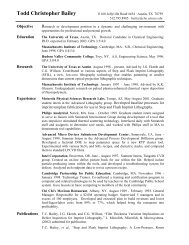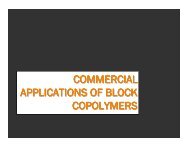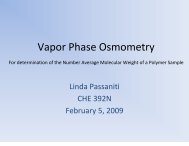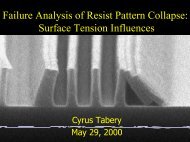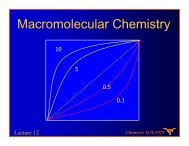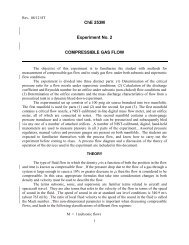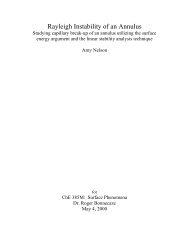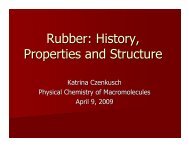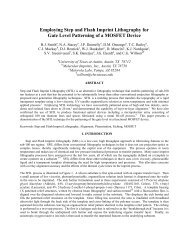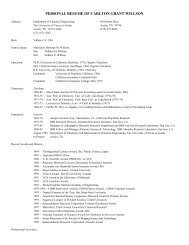Asymmetric fluid-structure dynamics in nanoscale imprint lithography
Asymmetric fluid-structure dynamics in nanoscale imprint lithography
Asymmetric fluid-structure dynamics in nanoscale imprint lithography
- No tags were found...
You also want an ePaper? Increase the reach of your titles
YUMPU automatically turns print PDFs into web optimized ePapers that Google loves.
similar. In Figures 6.7 and 6.8, the simulation results follow the experimentaldata for small values of time. For large t, there seems to be a DC offset <strong>in</strong> thedata. This discrepancy could be due to the factors previously discussed.Despite the differences <strong>in</strong> the actual values, these results <strong>in</strong>dicate that theassumption of a lubrication flow governed by Reynolds equation can be used tomodel the squeez<strong>in</strong>g process <strong>in</strong> SFIL. Further ref<strong>in</strong>ements can be made <strong>in</strong> boththe simulations and the experimental setup to obta<strong>in</strong> improved data, especially forsmaller film thickness measurements. An automated system that allows actualimpr<strong>in</strong>t<strong>in</strong>g of the template onto a wafer substrate would probably yieldrepeatability <strong>in</strong> the data and be less prone to particle contam<strong>in</strong>ation.6.4.2 Experiments with Unfiltered WaterThe follow<strong>in</strong>g data presented here are for two conditions. Initially, thewater used was unfiltered distilled water. It was believed that this water wassufficiently clean. However, it was decided that filter<strong>in</strong>g this water with 0.02-micron filters could not adversely the results. Therefore, the first set of data isfrom unfiltered distilled water and the second set is from filtered distilled water.In this section results from the experiments with unfiltered water are presented.Figure 6.10 shows that the gap decreases very little for six microns ofdownward actuation. Further, the change <strong>in</strong> the angle of <strong>in</strong>cl<strong>in</strong>ation relative to thesubstrate seems to be negligible. This suggests that particles between thetemplate and substrate have been squeezed very hard. Visual <strong>in</strong>spection throughthe quartz template shows that there are isolated particles distributed across thesurface of the substrate. However, only an automated active stage system canpotentially elim<strong>in</strong>ate particles.90



